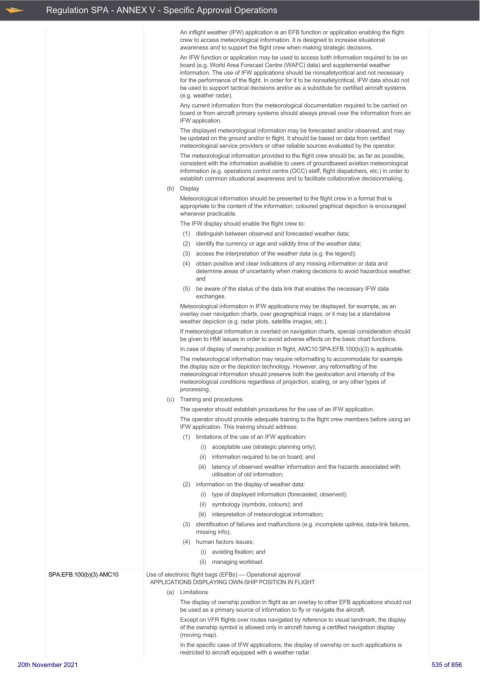Page 535 - UK Air Operations Regulations 201121
P. 535
~
~ Regulation SPA - ANNEX V - Specific Approval Operations Centrik
An inflight weather (IFW) application is an EFB function or application enabling the flight
crew to access meteorological information. It is designed to increase situational
awareness and to support the flight crew when making strategic decisions.
An IFW function or application may be used to access both information required to be on
board (e.g. World Area Forecast Centre (WAFC) data) and supplemental weather
information. The use of IFW applications should be nonsafetycritical and not necessary
for the performance of the flight. In order for it to be nonsafetycritical, IFW data should not
be used to support tactical decisions and/or as a substitute for certified aircraft systems
(e.g. weather radar).
Any current information from the meteorological documentation required to be carried on
board or from aircraft primary systems should always prevail over the information from an
IFW application.
The displayed meteorological information may be forecasted and/or observed, and may
be updated on the ground and/or in flight. It should be based on data from certified
meteorological service providers or other reliable sources evaluated by the operator.
The meteorological information provided to the flight crew should be, as far as possible,
consistent with the information available to users of groundbased aviation meteorological
information (e.g. operations control centre (OCC) staff, flight dispatchers, etc.) in order to
establish common situational awareness and to facilitate collaborative decisionmaking.
(b) Display
Meteorological information should be presented to the flight crew in a format that is
appropriate to the content of the information; coloured graphical depiction is encouraged
whenever practicable.
The IFW display should enable the flight crew to:
(1) distinguish between observed and forecasted weather data;
(2) identify the currency or age and validity time of the weather data;
(3) access the interpretation of the weather data (e.g. the legend);
(4) obtain positive and clear indications of any missing information or data and
determine areas of uncertainty when making decisions to avoid hazardous weather;
and
(5) be aware of the status of the data link that enables the necessary IFW data
exchanges.
Meteorological information in IFW applications may be displayed, for example, as an
overlay over navigation charts, over geographical maps, or it may be a standalone
weather depiction (e.g. radar plots, satellite images, etc.).
If meteorological information is overlaid on navigation charts, special consideration should
be given to HMI issues in order to avoid adverse effects on the basic chart functions.
In case of display of ownship position in flight, AMC10 SPA.EFB.100(b)(3) is applicable.
The meteorological information may require reformatting to accommodate for example
the display size or the depiction technology. However, any reformatting of the
meteorological information should preserve both the geolocation and intensity of the
meteorological conditions regardless of projection, scaling, or any other types of
processing.
(c) Training and procedures
The operator should establish procedures for the use of an IFW application.
The operator should provide adequate training to the flight crew members before using an
IFW application. This training should address:
(1) limitations of the use of an IFW application:
(i) acceptable use (strategic planning only);
(ii) information required to be on board; and
(iii) latency of observed weather information and the hazards associated with
utilisation of old information;
(2) information on the display of weather data:
(i) type of displayed information (forecasted, observed);
(ii) symbology (symbols, colours); and
(iii) interpretation of meteorological information;
(3) identification of failures and malfunctions (e.g. incomplete uplinks, data-link failures,
missing info);
(4) human factors issues:
(i) avoiding fixation; and
(ii) managing workload.
SPA.EFB.100(b)(3) AMC10 Use of electronic flight bags (EFBs) — Operational approval
APPLICATIONS DISPLAYING OWN-SHIP POSITION IN FLIGHT
(a) Limitations
The display of ownship position in flight as an overlay to other EFB applications should not
be used as a primary source of information to fly or navigate the aircraft.
Except on VFR flights over routes navigated by reference to visual landmark, the display
of the ownship symbol is allowed only in aircraft having a certified navigation display
(moving map).
In the specific case of IFW applications, the display of ownship on such applications is
restricted to aircraft equipped with a weather radar.
20th November 2021 535 of 856

